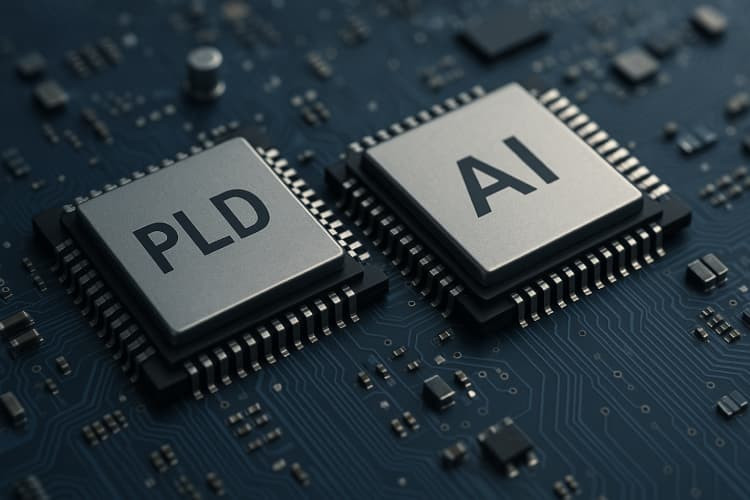Reconfigurable AI Chips Could Solve AI’s Hardware Crisis
Insights | 07-07-2025 | By Robin Mitchell

Key Takeaways:
- AI-specific hardware often becomes outdated faster than the models it’s built to support, creating a costly bottleneck.
- Imec is developing programmable AI chips using supercell and 3D stacking technologies to improve adaptability and energy efficiency.
- Reconfigurable architectures may help reduce the risk of stranded assets in the fast-moving AI space.
- Despite its potential, flexible AI hardware still faces technical and economic challenges in matching the performance of fixed-function GPUs.
While today’s AI capabilities continue to leap forward, the hardware designed to support them is struggling to keep pace. Unlike general-purpose CPUs, which age gracefully and remain compatible over time, AI chips often become outdated as quickly as the models they’re meant to run. This disconnect between fast-evolving algorithms and fixed-function silicon is becoming a serious bottleneck.
So, what makes AI hardware so inflexible, how are semiconductor leaders like imec tackling this issue, and could programmable chips be the key to unlocking a more future-proof AI infrastructure?
The Challenge with AI Hardware and Its Fixed Nature
The electronics world doesn't stand still. From vacuum tubes to today's cutting-edge semiconductors, it's been a relentless march of progress, and frankly, a glorious one. Microcontrollers have become the backbone of modern embedded systems, microprocessors sit at the heart of everything from smartphones to servers, and GPUs, once the domain of gamers and 3D artists, are now being shoehorned into just about every application, from image processing to deep learning. We're packing more power into smaller, cheaper devices with each generation.
But there's a catch: that progress comes with an expiry date, especially in AI.
Why Traditional CPUs Age Gracefully—But AI Hardware Doesn’t
A CPU from 10 years ago might be slow by today's standards, but it's still fundamentally a CPU. It runs the same logic, follows the same instruction sets, and plays nicely with any software written to standard architectures. You can upgrade it for performance, but it doesn't become functionally obsolete overnight.
AI hardware, on the other hand, is a different beast entirely. The pace of algorithmic advancement in machine learning and neural networks is blistering. We're not just refining old techniques, we're inventing entirely new architectures, from transformer models to diffusion networks, every few months. Each of these requires different computation patterns, memory layouts, and optimisation strategies.
So when you build specialised hardware for AI, whether it's a tensor processing unit, an AI-optimised GPU, or some proprietary ASIC, you're effectively locking yourself into today's way of doing things. And in a field that reinvents itself with every conference season, that's risky. The hard truth is this: AI-specific hardware is evolving so quickly that your brand-new silicon might be outdated before the ink dries on the datasheet.
Fixed-Function AI Chips vs Reconfigurable Alternatives
Contrast this with reconfigurable hardware like FPGAs. These chips can literally change their logic on the fly. If a new AI paradigm comes along that requires a different pipeline or architecture, you reflash the FPGA and move on. It's like getting a hardware upgrade without touching the physical hardware. For AI at the bleeding edge, this flexibility is priceless.
Unfortunately, most large-scale AI datacenters are built on racks upon racks of GPUs, great for parallel math, but not exactly agile when it comes to adapting to new algorithms. As AI evolves, those expensive server farms start to look less like innovation hubs and more like fossilised tech museums. You might be burning kilowatts and dollars just to run models that no longer align with best practices.
This rigidity isn't just a technical hurdle, it's a strategic liability. It narrows the scope of research by forcing developers to tailor their models to what the hardware can do, rather than what the science demands. That's backwards. It's like designing a car to fit the road, rather than building the road for the car.
Semiconductor Lab Imec Eyes Programmable AI Chips, CEO Says
In a move to address the challenges faced by the semiconductor industry in developing AI hardware, imec, a top semiconductor R&D firm, is exploring the development of programmable AI chips. According to Luc Van den Hove, CEO of imec, the industry needs to shift towards reconfigurable chip designs to avoid becoming a bottleneck in the future of artificial intelligence.
As Van den Hove explains, merely scaling up compute is no longer sustainable. “Adding more GPUs, data, and training time... won’t suffice to deal with a chain of various workloads,” he notes. Instead, what’s needed is a shift towards a more dynamic compute architecture where hardware can flexibly accommodate a diverse mix of reasoning, perception, and action models, often running simultaneously.
Why Scalable Compute Alone Can’t Meet Next-Gen AI Demands
In a recent interview, Van den Hove highlighted the challenges faced by the industry in developing AI hardware. He noted that rapid advancements in AI algorithms have outpaced the current strategy of developing custom, raw-power-focused chips. This has led to significant drawbacks in terms of energy consumption, cost, and hardware development speed.
This mismatch between software speed and hardware readiness has created what Van den Hove refers to as a “synchronisation issue.” AI workloads can change virtually overnight, such as in the case of Deepseek’s model innovation, whereas new chip designs can take years. This latency in hardware adaptation amplifies both cost and environmental concerns, especially as energy consumption scales.
Van den Hove also expressed concerns about the risk of "stranded assets" in the AI hardware industry. He noted that by the time AI hardware is ready, the fast-moving software community may have already taken a different direction. This risk is particularly high for companies that invest heavily in custom chip development, such as OpenAI.
The Stranded Asset Problem in Custom AI Chip Development
The risk of stranded assets is particularly acute in this high-velocity AI landscape. While tech giants like OpenAI are pursuing custom silicon development through partners like TSMC, Van den Hove suggests that for many, this route may not be viable given its cost, risk profile, and potential obsolescence by the time the chips ship.
Imec, a pioneer in semiconductor breakthroughs, has been at the forefront of developing new technologies that chipmakers like TSMC and Intel widely adopt. The company is now exploring the development of reconfigurable chip architectures that can adapt to changing AI algorithm requirements. According to Van den Hove, future chips will regroup all necessary capabilities into building-block-like structures called supercells. A network-on-chip will then steer and reconfigure these building blocks to meet the latest algorithm requirements.
These supercells are composed of vertically stacked semiconductors, where memory and logic sit in close physical proximity to reduce latency and energy loss. According to imec, this configuration could reduce data transfer distances from centimetres to nanometres, offering up to 80% energy savings, a compelling benefit as AI workloads become increasingly power-intensive.
Supercells and 3D Stacking: Imec’s Vision for Energy-Efficient AI Hardware
To achieve this, imec is looking towards true three-dimensional stacking, a manufacturing technique that involves bonding layers of logic and memory silicon together. Belgium-based imec was a key contributor to the advancement and refining of 3D stacking technology, which will be featured in TSMC's A14 and Intel's 18A-PT nodes.
Imec’s expertise in 3D stacking, exemplified by its role in shaping Europe’s NanoIC project, is seen as a linchpin in keeping European semiconductor innovation competitive. This initiative aims to bridge the gap between lab research and chip fabrication by fostering a more agile, vertically integrated ecosystem across AI startups, design houses, and foundries.
Imec will be hosting its flagship conference, IT F World, in Antwerp, Belgium, on Tuesday and Wednesday. The conference will bring together industry leaders and experts to discuss the latest developments in the semiconductor industry.
ITF World is expected to spotlight advancements in reconfigurable compute, chiplet integration, and RISC-V-based hardware standards, key themes in Imec’s roadmap to align silicon more closely with rapidly evolving AI algorithms.
Is Flexible AI Hardware the Answer, Or Just a Pipe Dream?
The idea of reconfigurable hardware for AI workloads is, on paper, a compelling one. The promise of adaptability, future-proofing, and model-agnostic execution hits all the right notes, especially when the pace of AI development makes last year's silicon look like a fossil. But just because an idea sounds great in theory doesn't mean it survives contact with reality.
Let's start with the elephant in the rack: AI workloads aren't your typical digital logic. They thrive on massive, fine-grained parallelism. That's why GPUs, with their thousands of cores and memory structures optimised for concurrent operations, dominate the AI space. Compare that to FPGAs, which, while marvels of flexibility, hit a wall when you try to scale them up for neural network-level compute.
Even if you tried to stitch together multiple FPGA packages to match the scale of a GPU, you'd be staring down some pretty nasty latency bottlenecks. Data doesn't magically teleport between chips. Intra-package bandwidth is king, and once you leave the boundaries of a tightly coupled die, the delays start piling up. This makes real-time inferencing or high-speed training an uphill battle, to say the least.
The Practical Limits of Scaling FPGAs for AI Workloads
Then there's the matter of density and efficiency. FPGAs are not known for their compactness. A function that fits snugly in a custom ASIC takes significantly more silicon real estate on an FPGA. That means more board space, more heat, and more power, three things datacenters are already juggling without much slack. So yes, you can build an AI accelerator out of reprogrammable logic, but you'll be paying a hefty premium in watts and watts per performance.
And look, datacenters aren't museums. They're built for max throughput and ROI. If you're trying to justify a rack full of flexible AI chips on the basis of future adaptability, you better have one heck of a performance roadmap. Otherwise, no CTO worth their salary is going to greenlight swapping out battle-tested GPUs for something that might adapt to the next model, eventually.
Balancing Performance and Flexibility in AI Chip Design
Realistically, what we'll probably see is a hybrid approach. The AI chips of the future might include limited reconfigurable components, embedded inside a largely fixed-function architecture. That's a smart compromise. Keep the bulk of the silicon optimised for today's most demanding tasks, but reserve some logic for algorithmic flexibility. It's not as flashy as a fully reprogrammable core, but it's far more likely to ship in volume and actually get used.
So, is flexible AI hardware a game-changer? It could be, but only in a narrow set of use cases. For edge deployments with evolving workloads? Maybe. For academic research into new architectures? Sure. But for the heavy hitters, training billion-parameter models or running real-time inference at scale, reconfigurable silicon isn't replacing GPUs any time soon.
At the end of the day, flexibility is great, but performance still pays the bills.

